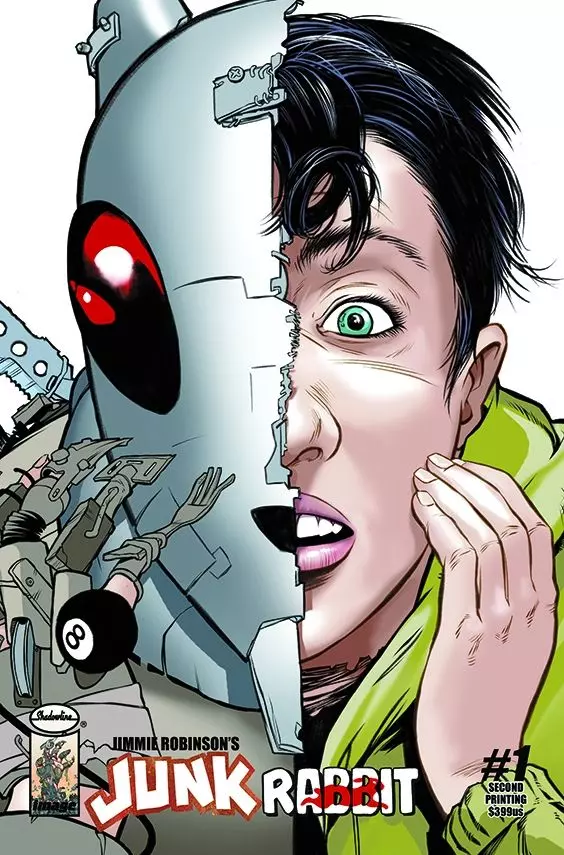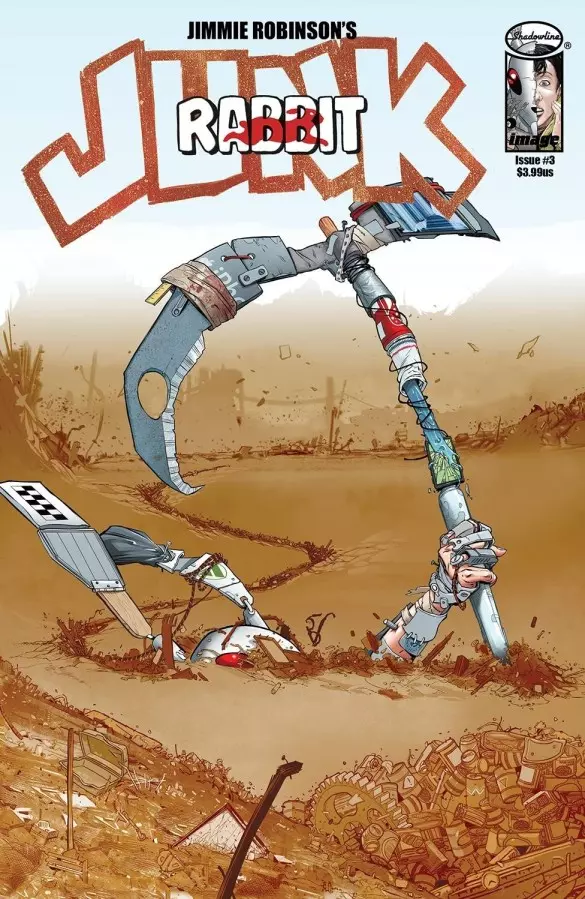Brad Cook chats with Junk Rabbit writer/artist Jimmie Robinson…
Jimmie Robinson has been plying his trade in the comic book industry since 1994, when he dipped his toe in self-publishing with the series CyberZone. He later signed with Image Comics and has been with the company since then, producing multiple series, including Amanda & Gunn, Code Blue, Bomb Queen, and others.
His latest is Junk Rabbit, whose second issue hit comic book store shelves recently; the first issue sold out and went into a second printing. Pitched as “Swamp Thing meets RoboCop,” it’s planned to be a five-issue series that will wrap up in August. It features a world of the not-too-distant future overtaken by consumer waste, with society’s have-nots forced to eke out an existence among piles of garbage.
Junk Rabbit is known to this world’s citizens as a vengeful vigilante who aims to take down the corporate rulers of a nearby domed city, but as the first issue opens, he’s thought of as little more than an urban legend. When sightings of Junk Rabbit pop up again, though, the residents of the junkyards begin to hope that maybe things will change.
Jimmie took some time out of his busy schedule to talk to me about his career, the ideas that led to the creation of Junk Rabbit, and his plans for not only Junk Rabbit’s future but also more great comics.
How did you get started writing and drawing comic books?
I started late. I was in my thirties when I got serious about pursuing comics. I had married early and had a child, so I knew I couldn’t dedicate all the time I wanted until my daughter was older. Meanwhile, I just continued with my day job, did some art on the side, and made plans to self-publish.
I created several writing drafts and attempted drawing full issues of comics. I always assumed if I wanted to draw comics that it was best to practice at drawing 22 to 32 pages. I was not really the type that drew a single image, or a character bust, or a cool pose; I worked on creating sequential work, like a filmmaker.
I finally got my act together in 1994 and self-published a title called CyberZone. I found a local printer and had about 1,000 copies made. Then I took them to comics stores and sold them directly to the retailers. I didn’t know anything about distribution, solicitation, etc. I just did it.
Keep in mind this was before the internet as we know it now. Everything was done by postal mail, phone calls, and meeting people at comic conventions.
After seven issues of bi-monthly publication of CyberZone, I realized I needed to regroup and figure out a better plan. I was losing money and readers, so I wrote an open letter to the comic industry media that I was cancelling my comic.
Three days later, I was getting calls from publishers asking if I’d like to create something for them. I had no idea others were watching my progress. They must’ve assumed I was doing okay without them.
I signed with Image Comics Publishing and I’ve been with them for over 20 years. In that time I’ve published a number of books, series and a franchise title.My books are sold internationally in different languages and continue to sell, bringing me quarterly royalties every year.
I am still learning the craft of sequential storytelling. I have no formal training or education in writing for the comic industry. It was decades of trial-and-error, and it continues even now. I basically “grew up in public” — meaning I presented my works to the world with warts and all.
What was the original inspiration for Junk Rabbit?
Inspiration isn’t something that usually helps me create my work. It comes in bits and pieces and orbits a concept or thought I might have in the background of my mind.
In this case, the bits came through osmosis due to my wife’s job at a non-profit organization. Her job entails reaching shareholders who own stock in companies and creating change from within those companies. These companies and corporations are often doing something they need to change, such as chemicals in food, plastic waste, and environmental issues. By advocating with shareholders, they can pressure CEOs to create better companies.
As a fly on the wall to my wife’s conversations, I started to think what a world would be like if companies had no restraint, ethics, or guidelines. I wondered how bad could it get without regulation. Meanwhile, I was playing with an idea about a rabbit character in another comic. A completely different context.
At the same time, I was transitioning from traditional pen and paper art to working on a digital tablet. This meant immersing myself into the process and basically just scribbling ideas and art until it felt natural. I would put on headphones and listen to audiobooks and try my best to submerge into drawing.
Some of the audiobooks were by Kim Stanley Robinson (no relation), who deals with *hard* sci-fi that’s more realistic than others. Often it’s termed “cli-fi,” as in climate-fiction.
All these things swirled in my orbit of thought until it landed on a planet called Junk Rabbit. But that was not enough. On that planet I had to find the country, the region, then the county and city, right down to the address of what is now the series Junk Rabbit.
How long will the series be, and what can readers expect for the rest of the issues?
Five monthly issues, 32 pages each, then collected into a larger graphic novel format.
I am hoping to surprise readers with a different type of character, because the character is literally a product of their environment. Often we think of heroes like we see today on the silver screen, but what will heroes be like in the future a hundred years from now? What will they represent?
This means more than just making a lead character and placing them in the world as we know it. This means world-building and thinking about society, politics and global issues.
It’s far more complex than just making Character X, who has the power of X, fighting against an evil X, etc. I call that window dressing. It says nothing about the people on the ground, the community that hero X serves, or even if the community wants the help of hero X. It’s often a void.
I set Junk Rabbit to be seen from the ground up. My focus is from the POV of others *about* Junk Rabbit because in this series the identity of Junk Rabbit is a mystery. I wanted a story where people talked about the hero, not where the hero talks about what they are doing to the reader. This creates a form of discovery for the reader.
Congrats on the first issue selling out and going to a second printing. How do sales for the rest of the series look so far?
I have no idea. Early in my career I would scour the numbers for comic book sales. There used to be a monthly TOP 300 list based on orders. Every month I would run to certain websites and see my rankings.
Sometimes it’s heartbreaking and I could see how some would be discouraged by the reception of their book. For me, it just made me work all the harder.
However, at that time I was publishing a series called Bomb Queen, which taught me a lot about my perception of sales. Bomb Queen was a *critic-proof* title. It was divisive, rude, and often extreme in nature. This made it a lightning rod of conversation no matter what side you stood on. Reviews were all over the place — but it continued to sell over the years. To this day I get royalty checks for that series I did over 10 years ago.
So I realized the long tail of sales are more important than the monthly numbers, especially when the entire work is wrapped into a single graphic novel. I now look at a book’s progress in years instead of months. It took a long time for that to sink in. Even now I’m still cautious, which is why this story arc is only 5 issues.
What’s your plan for the future of Junk Rabbit?
The success, so far, did create a question from my publisher. Did I want to continue beyond the story arc of five issues? I did consider this for a week.
I admit, I do have another longer story idea for a Junk Rabbit sequel. However, I decided to hold off until I get other things done. The problem is that I do everything on the comic, so it takes me longer to produce it and I fear falling behind on a monthly publication. Also, I have other story ideas for other books I want to do, so I want to exhaust some of those projects.
And what are your plans for future comic books beyond Junk Rabbit?
I actually have a fully done comic series, right now! As I noted before, I do everything on a comic, so the monthly grind can be exhausting. Three years ago, I took the time to do an entire series *before* publishing so it can all be done. However, nobody wanted it, or didn’t respond to it. Now it’s just sitting here collecting dust.
I am hoping Junk Rabbit will give me leverage to get it looked at again. The ironic thing is the story was about AI art taking over the world. I was ahead of the curve and didn’t even know it. My hope is the story can get traction now that everyone knows about AI art.
I also have a sci-fi story that involves issues on race. I wrote it and even sketched out dozens of layout pages ready for art. Just need the time. Time… what a concept.
Many thanks to Jimmie Robinson for taking the time for this interview.
Brad Cook
This post was originally published on this site be sure to check out more of their content.












